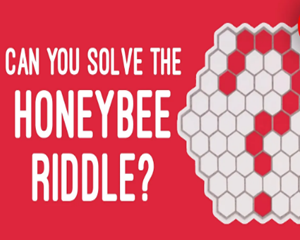You're a biologist on a mission to keep the rare honeybee Apis Trifecta from going extinct.
作为生物学家,你正在执行一项防止稀有蜜蜂Apis Trifecta绝种的任务。
The last 60 bees of the species are in your terrarium. You've already constructed wire frames of the appropriate size and shape.
最后的60只蜜蜂就在你的饲养室里,你已构建了合适大小和形状的巢框。
Now you need to turn them into working beehives by helping the bees fill every hex with wax.
现在要把它们变成正常工作的蜂巢,你需要往每个六边形里充蜡。
There are two ways to fill a given hex.
充蜡有两种方法。
The first is to place a bee into it. Once placed, a bee cannot be removed without killing it.
第一种是放一只蜜蜂进去,蜜蜂一旦放入便不能拿出,除非杀死它。
The second: if at any point an unfilled hex has three or more neighboring wax-filled hexes, the bees already in the hive will move in and transform it.
第二种方法,如果一个空六边形与三个以上充蜡的六边形相邻,蜂巢中的蜜蜂就会进入该六边形充蜡。
Once the bees have transformed every hex in a hive, you can place an additional bee inside and it'll specialize into a queen.
一旦蜜蜂完成蜂巢里所有六边形的充蜡,你再放入一只蜜蜂,它就会变成蜂王。
The hive, if well cared for, will eventually produce new bees and continue the species.
如果精心照料,蜂巢就会产生新的蜜蜂,将这个物种延续下去。
If there are no hexes with three or more transformed neighbors, the bees will just sit and wait.
如果没有与至少三个充蜡六边形相邻的空六边形,蜜蜂只能干等。
And once a bee transforms a hex, it can never become a queen.
而且充腊蜜蜂无法成为蜂王。
You could put 59 bees in one wire hive, wait till they transform all the hexes, and then create a queen.
你可以把59只蜜蜂放入蜂巢框架,等待它们为所有六边形充蜡后,再创造一个蜂后。
But then just one collapse would end the species. The more viable hives you can make now, the better.
但只要一次失败,就会导致该物种灭绝,所以,你现在制造的蜂巢越多越好。
So how many can you make with 60 bees?
那么60只蜜蜂能造多少个蜂巢呢?

What you're looking for here is some kind of self-sustaining chain reaction, where a small number of bees will transform an entire hive.
这里你需要用到的方法是所谓的“自持链式反应”,只需少量蜜蜂即可完成蜂巢充蜡。
The lower the number of bees needed, the better.
需要的蜜蜂数量越少越好。
So how low can we go, and how can we engineer a chain reaction? Let's start with the first question.
那最少需要多少只蜜蜂,又如何设计链式反应呢?就从第一个问题开始吧。
There's a really clever approach to this, which involves counting the sides of the filled-in hexes, and examining their total perimeter.
有个非常巧妙的方法,那就是计算充蜡六边形的边数,并算出它们的总周长。
Let's suppose we put bees in these three hexes. The total transformed perimeter has 18 sides.
假设把蜜蜂放在这三个六边形里,充蜡后的周长共有18条边。
But the middle hex has three transformed neighbors, so the bees will transform it too.
但中间的六边形与三个已充蜡的相邻,所以,蜜蜂也会对它充蜡。
What happens to the perimeter? It's still 18!
现在周长是多少呢?还是18!
And even after the bees transform the next sets of hexes with three neighbors, it still won't change. What's going on here?
即便蜜蜂完成下一轮对三个充蜡邻居的六边形充蜡后,周长依然不变。这是什么道理呢?
Each hex that has at least three sides touching the bee-friendly space will remove those sides from the perimeter when it transforms.
至少有三个充蜡邻居的六边形在蜜蜂完成充蜡后,相邻边要从周长中剔除。
Then it adds at most three new sides to the perimeter. So the perimeter of the transformed hexes will either stay the same or shrink.
然后最多给周长增加三条新边。因此,充蜡六边形的总周长要么不变,要么变小。
The final perimeter of the entire hive is 54, so the total perimeter of the hexes we place bees in at the start must be at least 54 as well.
整个蜂巢的总周长是54,所以,我们一开始放入蜜蜂,这些六边形的周长至少是54。
Dividing that 54 by the six sides on each non-adjacent hex tells us it'll take at least 9 bees to transform the entire hive.
用54除以一个六边形边数6,得出至少需要9只蜜蜂才能完成整个蜂巢的充蜡。
That's a great start, but we still have the tough question of where the nine bees should go, and if we'll need more.
这个开头不错,但棘手的问题是,这9只蜜蜂该放哪里,以及是否需要放入更多蜜蜂。
Let's think smaller. We already know that three bees could completely transform a hive this big. What about a slightly bigger one?
让我们想想小一点的蜂巢。我们已知3只蜜蜂能完成这么大蜂巢的充蜡,稍微大一点的蜂巢会怎样呢?
The perimeter of this hive is 30, which means we'll need at least 5 bees to fill it in. With 6 it'd be easy.
这个蜂巢的周长是30,意味着我们至少需要5只蜜蜂完成充蜡。6只蜜蜂就轻松完成。
Placing them like this would fill out the whole hive in just three steps. But we can do better!
这样放置只需要三步就能完成整个蜂巢充蜡。但我们可以做得更好!
We don't actually need to place a bee on this hex, since the other bees will transform that spot on their own.
其实勿需把蜜蜂放入该六边形,因为其它蜜蜂会为它充蜡。
It looks like we have the beginning of a pattern. Can we extend it to our full hive? That would mean placing our 9 bees like so.
看起来这个模式有了一个良好的开端,能把它扩展到整个蜂巢吗?即把我们的9只蜜蜂都放在类似位置。
Once they get to work, they'll create a chain reaction that fills in the center of the hive and extend it to its edges.
一旦蜜蜂开始工作,就会产生连锁反应,直至填满蜂巢中心,并延伸到蜂巢边缘。
Add a 10th bee to the completed hive and it becomes a queen.
在完工的蜂巢中放入第10只,它就会变成蜂王。
Repeat that process five more times and you've helped the last 60 members of Apis trifecta create 6 producing hives.
重复这个过程五次,你就帮最后的60只Apis trifecta蜜蜂建成了6个蜂巢。
All in all, it's a pretty good bee-ginning.
总之,这个开端相当不错。


